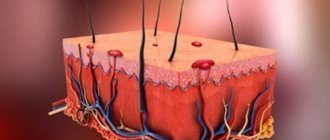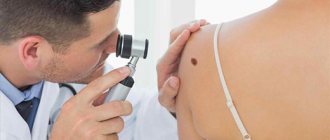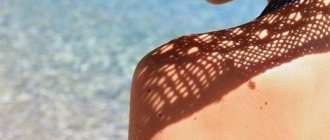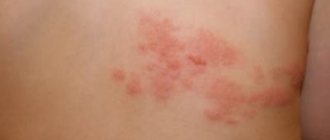Nevi (moles) are benign formations on the skin. They can have different colors, sizes and shapes. Moles begin to actively appear on the skin during puberty. These formations do not harm a person, but if they begin to change, then you need to consult a doctor.
What to do if a mole itches? How to eliminate unpleasant symptoms? Which doctor should I contact if itching occurs? In this article we will answer all questions in detail.
Provoking factors
Why does a mole itch? Itching of the nevus and the skin around it is provoked by cancerous and non-cancerous factors. In the first case, lack of treatment leads to the development of cancer.
Non-cancerous causes
- Itching due to an allergic reaction to food, fabric, medications or cosmetics.
- Rubbing the mole and the skin around it. This can happen when wearing tight clothes or underwear. In this case, it is better to remove the nevus surgically.
- Insect vinegar.
- Skin diseases. A person is bothered by itching of all moles at once. Unpleasant symptoms disappear after a course of therapy.
The above factors do not require immediate medical attention. For treatment, ointments, gels or tablets are used. The drugs are prescribed by the doctor after he conducts examinations. Self-medication is extremely dangerous.
Cancerous causes
The process of malignancy is the transformation of a nevus into an oncological tumor. If a mole itches and changes its shape, color and size, this indicates active cell division. A benign tumor can become malignant (melanoma) for the following reasons:
- Hormonal imbalance. This occurs during puberty, menstruation, pregnancy or postmenopause. Corticosteroids and hormonal drugs also have a negative effect on nevi.
- Ultraviolet radiation. Each person has a different safe dose of solar radiation. Excessive exposure to ultraviolet radiation on the epidermis leads to the development of skin cancer. Prolonged exposure to the sun and frequent visits to the solarium have a negative impact on benign formations.
- Injury to the nevus. If a mole itches severely due to damage, you should immediately consult a dermatologist. The injury may cause bleeding. The affected area must be treated with hydrogen peroxide or iodine.
- Massage. It can cause active cell division. Long and strong massage movements can cause inflammation of the epidermis. If the nevus not only itches, but also hurts, then you should consult a doctor.
It is extremely difficult to independently identify the reason why moles itch. Contact a dermatologist or oncologist immediately after detecting suspicious symptoms.
What is a mole
Why do moles appear and what are they? A mole (the medical term for this skin growth is a nevus) appears on the human body due to the accumulation of melanin pigment in the skin cells, which gives these bumps on the surface of the skin a dark color. There are more than ten types of nevi, the most common are:
- angiomas - red moles, which are a plexus of microscopic blood vessels;
- lentigo - pigment spots on the surface of the skin of a uniform dark color;
- intradermal nevi are dark formations of medium and large sizes protruding above the surface of the dermis, with hair growing from their center.
In newborns, the skin is practically free of moles and birthmarks. Most of these formations occur in childhood, sometimes new ones can appear in an adult. Seemingly harmless dark spots, areas or bumps on the skin are not only an unpleasant aesthetic problem. Over time, they can change:
- increase in size;
- change color;
- inflame.
If you notice that a mole has begun to grow, or itching or pain appears, do not delay and make an appointment with a dermatologist. Nevi capable of degeneration can cause the formation of benign and malignant skin formations, in some cases leading to the development of a serious disease - melanoma, one of the most dangerous types of skin cancer.
Only a doctor can determine what processes are occurring in a mole if it begins to bother you. The doctor is able to recommend protective measures to prevent the development of a dangerous disease and improve the general condition of the skin. General prevention of diseases caused by the activity of pigmentation processes includes:
- avoiding exposure of the skin to ultraviolet rays and radiation waves;
- preventing skin damage;
- control of general hormonal levels.
Oncological transformation
In medicine, there are signs that distinguish ordinary moles from malignant formations. They are briefly denoted by the letters ABCDE:
- A - asymmetry. The appearance of melanoma is significantly different from a nevus. Malignant formation does not have a clear shape.
- B - boundaries. Melanoma, unlike moles, has blurred and uneven edges.
- C - color. Benign formations have a certain shade (light and dark brown, black). Melanomas can be of different colors: red, bluish, yellow, pink, orange.
- D—diameter. In most cases, moles are small in size. If it has become several times larger, you should immediately consult a doctor.
- E - changes. If a mole begins to itch, change in color and size, you should be examined by a dermatologist. Such symptoms often indicate the development of skin cancer.
It is not always possible to make a diagnosis based on the appearance of moles. There is a certain group of formations - atypical nevi. They are harmless until they begin to develop.
What are the consequences of not treating an itchy mole?
If a birthmark begins to itch, and a person ignores a visit to a specialist for a more detailed examination, the risk of the birthmark transforming from benign to malignant increases. This modification is quite difficult to treat or cannot be treated at all.
If a mole has been removed using one of the existing methods, and the place itches, hurts, and has become bulging, there is bleeding, discharge of purulent masses, it is recommended to urgently consult a dermatologist. He will conduct a thorough examination and prescribe appropriate tests that will determine the cause of the unpleasant symptoms. After which the person will be prescribed treatment that will relieve itching, pain, and help avoid complications.
Conditions under which you should consult a doctor
Increase in mole diameter
There is no need to run to an oncologist if you have a slight itch around a mole. Tingling may occur due to a stressful situation or experience. You should consult a doctor if you have the following symptoms:
- Changes in the color, shape and size of a mole. It may also become bulging.
- Painful sensations. They appear as a result of the development of malignant tumors or damage to the epidermis.
- The skin around the nevus turned red and peeling appeared.
- Bubbles filled with liquid form on the surface of the mole.
- The appearance of light growths on a mole. This symptom is associated with active cell division.
- A person experiences discomfort, a burning sensation in the area of education.
- The surface of the nevus becomes rough and small cracks appear.
It is also necessary to urgently consult a doctor if the red mole itches. This sign indicates inflammation.
Under no circumstances should you scratch a mole or try to eliminate unpleasant symptoms using traditional medicine and medications. This will only make the condition worse. If you have an itchy mole on your stomach, armpits, neck or shoulders, apply a patch to it. Do not touch the formation until you visit a dermatologist.
Symptoms of degeneration of a birthmark
Malignization is the process of transition of benign tumors to malignant formations. Within the framework of the topic, this means that the birthmark turns into melanoma. In addition to itching, signs of degeneration include:
- asymmetrical shape - the nevus began to change shape;
- blurred boundaries. Under normal conditions, the mole has a clearly defined outline; if it is blurred, it’s time to sound the alarm;
- pain on palpation and contact with surfaces;
- heterogeneity of color. In the absence of pathologies, the mole has a certain color: pink, light brown, almost black. If the spot itches badly and has dark or light inclusions, you should be wary;
- increased size;
- change in structure. Cracks and growths appeared on the mole;
- altered density;
- loss of hair that grew on the surface of the nevus;
- moisture content of the stain surface;
- bleeding
It doesn’t matter whether the mole has become inflamed as a result of an injury or the process of its degeneration has begun - in any case, therapeutic measures must be taken.
Why does a removed mole itch?
If the place where the nevus was begins to itch, you should consult a doctor again. There may have been a relapse. This is due to the fact that cryodestruction cannot remove all pigment cells the first time. Such symptoms cannot be ignored. Timely contact with an oncologist or dermatologist will help prevent the development of skin cancer.
Attention! If a mole itches and you want to remove it, you need to have it done by a qualified specialist. You should not undergo this procedure with a cosmetologist.
What to do if the nevus itches?
What to do if a mole itches? It all depends on what process is causing it. If the anomaly is associated with inflammation, you can treat the birthmark with ichthyol or erythromycin ointment.
Compresses made from decoctions of medicinal plants, which have antiseptic, anti-inflammatory and soothing effects, help well:
- chamomile;
- calendula;
- sage;
- St. John's wort;
- celandine.
You can purchase an ointment based on calendula extract and treat painful nevi with it. But such therapy is carried out only on the condition that the reasons why a mole on the neck, back, arm or other part of the body itches is not related to the process of its degeneration into melanoma.
Treatment with antiseptic solutions should be carried out regularly, regardless of whether any ointments or herbal decoctions are used or not. The drugs Furacilin (not an alcoholic solution, but an aqueous solution!) and Chlorhexidine help relieve inflammation and redness of the epidermis.
Important! If a mole itches and hurts, you should never lubricate it with alcohol! In the absence of antiseptic agents, you can treat the growth with vegetable oil, which will protect it from infection and slightly moisturize dry and flaky skin.
to the table of contents?
How is melanoma treated?
If moles on the body itch due to their malignancy, medical intervention is necessary! It is the nevi that degenerate into melanoma, which is treated through surgery.
In this case, only the malignant neoplasm is removed. Consequently, healthy areas of the skin are not affected. After excision of the tumor, a sample of its tissue is sent for additional cytological examination.
If you consult a doctor in a timely manner, the prognosis for recovery is favorable. But if you postpone a visit to an oncodermatologist, the consequences can be very serious!
to the table of contents?
What are the consequences of not treating an itchy mole?
When a mole itches and itches due to degeneration into a malignant tumor, this can lead to extremely dangerous complications. Melanoma is the most dangerous malignant skin tumor, characterized by rapid development. But that's not even the worst thing.
Melanoma is prone to rapid metastasis to internal organs, and the lack of medical intervention can even lead to death. Therefore, if the skin around a mole itches, it begins to bleed, changes color and shape, you cannot hesitate. Although older people and males are most susceptible to melanoma, it can develop from an ordinary birthmark in anyone, and even in a small child.
Diagnostics
To detect skin cancer, the patient must see an oncologist or dermatologist. When you see a doctor, you need to talk in detail about the symptoms and changes that have occurred with the nevus. After this, he will conduct a full examination of the epidermis for the presence of malignant formations.
A dermatologist examines a patient's mole using a dermatoscope
In the early stages of skin cancer development, it is difficult to make a correct diagnosis. The doctor may order tests:
- Biopsy. The oncologist takes a particle of the nevus or removes it completely for examination.
- Histology. To detect cancer cells, the nevus is placed in a special solution and then carefully examined under a microscope. Using histology, the type of formation can be reliably determined.
- Blood test to check for cancer cells. It is carried out only when melanoma is detected. This test helps determine the level of LDH (lactate dehydrogenase).
After receiving the diagnostic results, the doctor will prescribe the most suitable treatment method for you. If moles itch for non-cancerous reasons, then gels, ointments or tablets can be used to eliminate unpleasant symptoms.
How to deal with itching around a mole
After consultation with a dermatologist or oncologist, it is determined that the cause of the itching is external factors, and you should carefully consider eliminating them. Since, by scratching an itchy mole, you can accidentally tear it off, which is fraught with negative consequences in the future. To eliminate it you need to:
- Take care of your tan. Avoid direct sunlight between 10 a.m. and 5 p.m. At this time, ultraviolet light is not beneficial for the skin. There is a risk of getting burned. Always use special creams.
- Use clothing made from high-quality materials to avoid rubbing, which can cause injury to the birthmark.
- Change cosmetic products. They should not contain synthetic components that can cause an allergic reaction.
To avoid itching of the nevus, which occurs due to dry skin, it is recommended to use moisturizers.
When taking medications, one of the side effects may be itching, so you should pay attention to this. A mole may also itch due to taking hormonal medications. It is necessary to consult a doctor so that he can prescribe another remedy. The wrong foods can cause itching. To avoid such an unpleasant phenomenon, you should reconsider your diet. Its composition should include as little flour, sour and salty foods as possible, as well as smoked foods. If the itching appears infrequently, but is intense, it can be relieved by pressing on the nevus for five seconds. You should not scratch a mole to avoid scratching or tearing it off.
There are other methods to help get rid of itching. Before using one of them, it is recommended to consult a doctor so as not to aggravate the condition of the nevus. These methods include:
- Celandine. You need to use the juice of this plant. Apply to the itchy area once a day, preferably at night.
- An effective remedy is a combination of garlic and lemon. Initially, apply a few drops of lemon juice to the mole. After 5 minutes, drop a similar amount of garlic juice onto the same place. Perform this procedure several times a day.
- The use of natural liquid honey can relieve itching and reduce the inflammatory process. Lubricate morning and evening.
- Take a few drops of apple cider vinegar, drop it on the itchy area, and wait until it dries. Carry out the procedure two to three times a day.
- Apply oak bark solution to the mole.
- Brew chamomile flowers and a string. Soak a cotton swab in the resulting decoction and apply it to the nevus for a few minutes. Apply lotions several times a day.
Papillomatosis as a cause of peeling
A very common process, often provoked by human papillomaviruses.
Outwardly it looks like a small outgrowth of skin, single or multiple.
People sometimes call this formation a pedunculated mole, although papillomas are not classified as pigmented formations.
Unfortunately, they can become malignant and transform into squamous cell skin cancer.
The most common malignant cause of peeling is basal cell carcinoma.
This is a relatively rare metastatic tumor.
It grows slowly and often appears on the scalp, face and other exposed parts of the body.
One form, nodular basal cell carcinoma, may contain patches of melanin, which makes it resemble a large, growing mole.
Areas of peeling are observed around the pigment spot, crusts are formed, and the color of the node becomes uneven.
For squamous cell carcinoma, desquamation is not as common.
This process often occurs with lesions at the site of previously benign tumors.
For example, where there was recently a hanging mole.
Separately, it is worth dwelling on hemangiomas.
These are vascular, benign tumors that in the early stages look like a reddish spot and can easily be confused with a mole.
Often found in children.
Typical location:
- on the lip;
- on the skin of the back;
- on the genitals (labia, vulva, foreskin of the penis).
Hemangiomas of the abdomen and extremities are less common.
Peeling is not typical for them.
It may indicate either a near resolution of the process (spontaneous recovery from hemangiomas is not uncommon) or a progression of the pathology.
After removal, the mole began to itch and hurt: how dangerous is the condition?
Mole removal is a surgical procedure that involves excision of a spot.
It can be carried out with a scalpel or minimally invasive methods: laser coagulation, diathermoelectrocoagulation, cryodestruction, radio wave method.
It is necessary to follow the rules of preparation and postoperative care, otherwise keloid scars appear, the mole itches after removal, the state of health is disturbed, pain occurs, recurrence of the nevus, and suppuration of the wound area.











